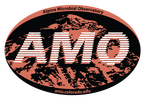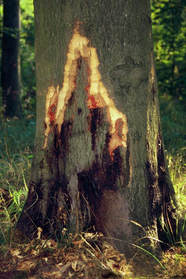|
by Cliff Bueno de Mesquita Happy new year’s eve from all of us here at the AMO! I am writing this post from little Rhode Island (where I grew up), so I decided to write about a local microbe. So this month’s microbe is a genus called Phytophthera. Phytophthera is a type of microorganism called an oomycete, which is different from, say, a bacterium or a fungus. Oomycetes are often described as being quite similar to fungi, but they form their own unique lineage on the phylogenetic tree of life. They are filamentous, spore-producing organisms that often function as either saprotrophs (organisms that decompose organic matter), or plant pathogens, living on plants and causing them harm. Unlike fungi, whose cell walls are made of chitin, Phytophthera cell walls are made of cellulose. There are 232 described species and species variations in the genus, though it is estimated that there could be as many as 200-300 more that we have not discovered yet! One of the most common tree diseases in Rhode Island is Phytophthera root rot, which occurs on beech trees. The Phytophthera oomycete in this case infests the beech tree roots, but infected trees will also show bleeding cankers on the trunks (Figure 1). Phytophthera root rot is a leading cause of death for older beech trees. But the Phytophthera genus is actually quite widespread and infects thousands of plant species, including important forest trees like chesnuts, oaks, and alders, and important crops such as strawberries, citrus trees, cucumbers, squash, soybeans, tomatoes and potatoes. Most notably, the species Phytophthera infestans caused the potato blight that led to the Great Irish Potato Famine of 1845-1849!
References: Goheen EM, Frankel SJ, eds. 2007. Phytophthoras in Forests and Natural Ecosystems. Albany, CA, USA: USDA Forest Service: General Technical Report PSW-GTR-221, 101–15. https://www.fs.fed.us/psw/publications/documents/psw_gtr221/psw_gtr221.pdf Kaiser Tree Preservation Co. 2018. Top 10 Tree Diseases in Rhode Island. http://kaisertree.com/services/plant-health-care-2-2/top-10-tree-diseases-in-rhode-island/ NCBI. 2018. Phytopthera. NCBI taxonomy. Bethesda, MD: National Center for Biotechnology Information. https://www.ncbi.nlm.nih.gov/Taxonomy/Browser/wwwtax.cgi?mode=Tree&id=4783&lvl=3&keep=1&srchmode=1&unlock Nowicki M, Foolad MR, Nowakowska M, Kozik EU. 2011. Potato and tomato late blight caused by Phytophthora infestans: An overview of pathology and resistance breeding. Plant Disease, 96: 4–17, doi:10.1094/PDIS-05-11-0458
0 Comments
|
AuthorVarious lab members contribute to the MoM Blog Archives
October 2023
Categories |


 RSS Feed
RSS Feed
